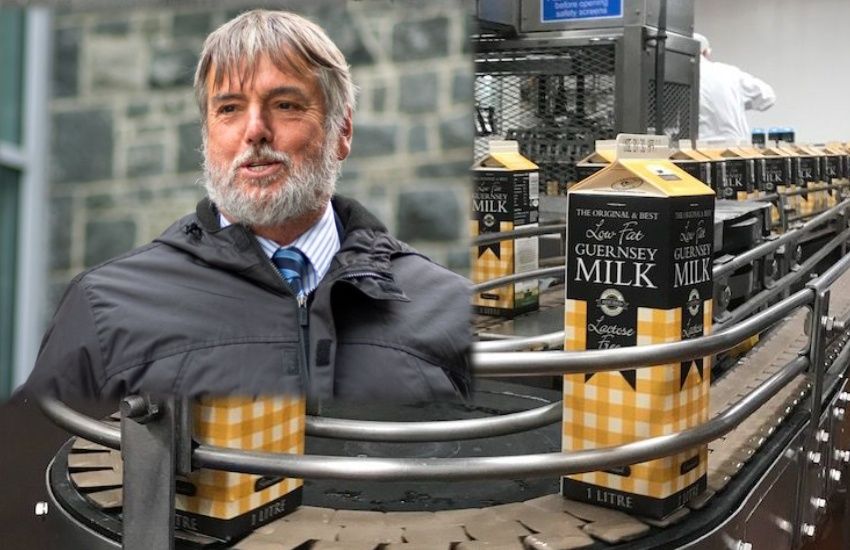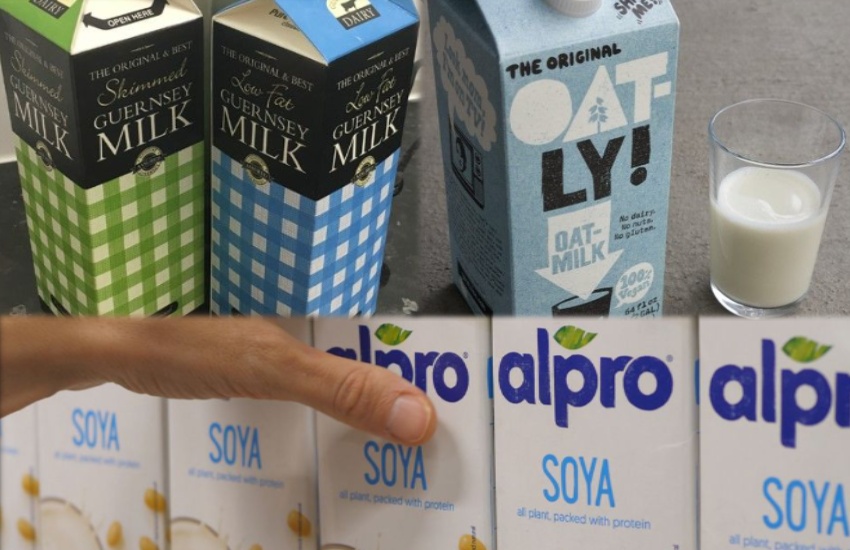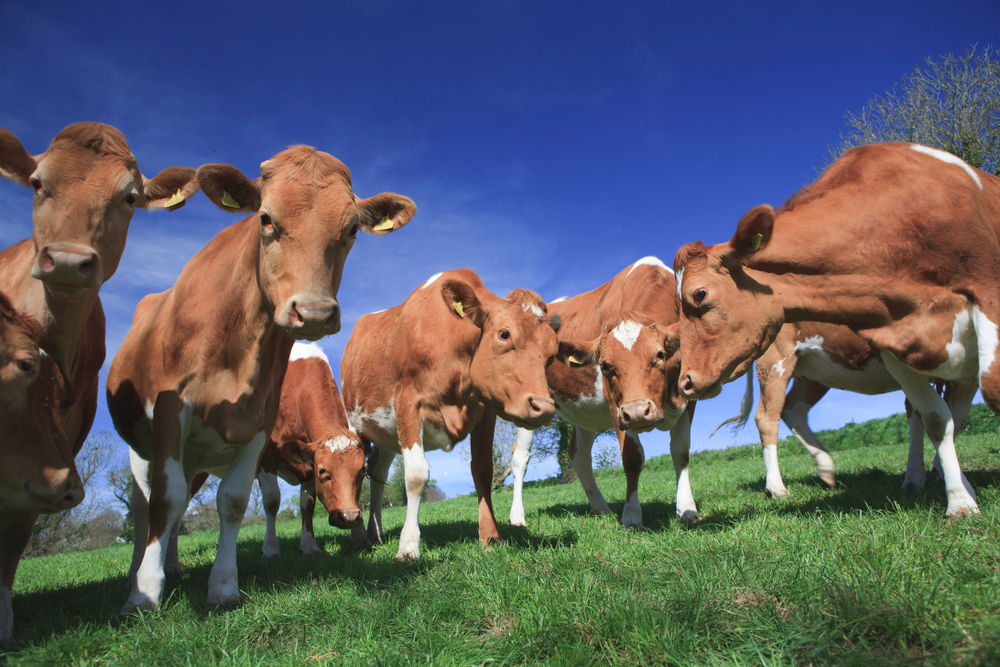


Sales of Guernsey milk by volume increased by around 1% in 2021 - but proposals being drawn up for a new dairy will continue to assume ongoing reductions in sales of around 1.5% per year.
Sales fell by more than 5% in the two years before the covid-19 pandemic hit the island and the States' Trading Supervisory Board, the committee which runs the dairy, thinks the price of local milk and lifestyle changes will continue to drive down reductions in demand in the years ahead.
"There has been some reduction in sales of liquid milk in recent years, coinciding with price increases, but research tends to suggest that is as much a result of lifestyle changes as it is to do with cost," said the President of the Board, Deputy Peter Roffey.

Pictured: Sales of cow's milk are forecast to decline in the long term as more consumers turn to alternatives such as oatmilk and soya milk.
"Logically, there is a limit to how high the price of milk can rise and remain affordable, but the Board does not currently have a view on what specifically that level is. [Research] would suggest that the level has not yet been reached, but the relatively high price - for what is a premium product, without the economies of scale available elsewhere - is still a concern for the Board.
"The efficient operation of the dairy and the dairy farming industry is paramount. In 2014, the States made the decision to reduce the level of subsidy provided to the farming industry. This has reduced, in real terms, from around £3.3million per year to the current £1m. A significant proportion of the subsequent increases in the retail price of milk can be attributed to this reduction in direct government support."

Pictured: The dairy sold more milk by volume in 2021 than in 2020 and the amount of milk it receives above what it needs to meet market demand has been reduced.
Deputy Roffey also revealed that surplus milk taken in by the dairy from local farmers - the difference between the volume needed and what is actually supplied - "has been reduced significantly" since it was estimated at approximately one million litres annually a few years ago.
"Surplus milk received last year was around 400,000 litres, which in very simple terms equates to a cost of approximately £230,000," said Deputy Roffey.
"The dairy has a robust pricing structure in place agreed with farmers that encourages production within set thresholds over a rolling 12-month period...[but] raw milk production cannot be precisely controlled due primarily to environmental factors outside of farmers’ control.
"The dairy does make use of all milk it is obliged to accept. Any surplus is processed as residual milk, with the cream extracted through the skimming process and used to make butter. Only the remaining liquid - effectively white water - is discarded as currently there is no resale value, but investigations are continuing to find a use for it."

Pictured: Milk received by the dairy above market demand is turned into milk by-products, such as butter.
The Board said there are currently 12 local dairy farmers with approximately 1,360 milking cows. Their total milk production was 7.9m. litres in 2020 and 7.6m. litres in 2021.
"It is estimated that around 7.2m. litres of raw milk are required annually to meet existing demand. However, that would only be sufficient if raw milk intake at the dairy is maintained at a consistent level over a rolling 12-month period, which is generally not the case," said Deputy Roffey.
"The limitations of the existing site and the variation in raw milk volumes between spring and autumn keep the current requirement at around 7.6m. litres, but this could be reduced with a new facility."
The Board is currently preparing an outline business case for the proposed development having confirmed "a new dairy on a new site as the preferred way forward".

Pictured: Deputy Neil Inder (right), the President of the Committee for Economic Development, submitted Rule 14 written questions to Deputy Peter Roffey, the President of the States' Trading Supervisory Board.
Deputy Inder asked whether the dairy should continue to be owned by the States.
The Board reminded him that States' ownership of the dairy was reaffirmed by the States' Assembly - in a unanimous vote - as recently as July 2020.
Deputy Roffey said: "Continuing commitment to the Guernsey breed and an independent but still States-owned dairy were two elements of the overall policy framework set out in the 2014 review and subsequently endorsed by the States [in 2014 and again in 2020].
"Other elements include effective statutory control over the importation of milk, support for farm business development and protection of agricultural land..[t]he overall 10-point plan represented a comprehensive, coherent vision and policy for the local dairy industry.
"Maintaining States’ control over the financial mechanism that funds the local dairy farming industry, through maintenance of a States-owned dairy, does afford the States a degree of direct control over land management, farming practices and animal welfare."

Pictured: There are currently 12 dairy farmers with approximately 1,360 cows.
Deputy Inder, who is the President of the Committee for Economic Development, also asked the Board for evidence of links between the preservation of the Guernsey breed of cattle and the island's agricultural economy.
Deputy Roffey said: "There is...an inextricable link between the local dairy industry and Guernsey’s agricultural economy. Milk production remains the most important farm enterprise in Guernsey, with the sale of milk to the dairy the major revenue stream for local dairy farmers.
"The 2014 dairy industry review found that, of 15,250 vergees of agricultural land, more than 8,000 vergees were currently in use for dairy farming. However, it is worth noting that the 2014 review refers only to around 10,000 vergees of land being used each year in productive agriculture, suggesting that a much higher proportion of land in use is dedicated to dairy farming.
"The direct economic benefit to the island of this industry has been calculated [in 2020] to be around £2.4m. a year."
Preferred site chosen for new dairy
Farmers to benefit from milk price rise
Guernsey Dairy wins prestigious taste awards
Comments
Comments on this story express the views of the commentator only, not Bailiwick Publishing. We are unable to guarantee the accuracy of any of those comments.